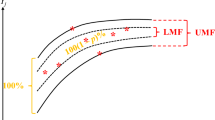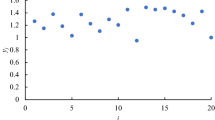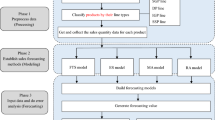Abstract
Forecasting future productivity is a critical task to every organization. However, the existing methods for productivity forecasting have two problems. First, the logarithmic or log-sigmoid value, rather than the original value, of productivity is dealt with. Second, the objective functions are not consistent with those adopted in practice. To address these problems, a fuzzy polynomial fitting and mathematical programming (FPF-MP) approach are proposed in this study. The FPF-MP approach solves two polynomial programming problems, based on the original value of productivity, in two steps to optimize accuracy and precision of forecasting future productivity, respectively. A real case was adopted to validate the effectiveness of the proposed methodology. According to the experimental results, the proposed FPF-MP approach outperformed six existing methods in improving the forecasting accuracy and precision.











Similar content being viewed by others
Explore related subjects
Discover the latest articles, news and stories from top researchers in related subjects.Abbreviations
- ANN:
-
Artificial neural network
- ARIMA:
-
Autoregressive integrated moving average
- DEA:
-
Data envelopment analysis
- DRAM:
-
Dynamic random access memory
- FCI:
-
Fuzzy collaborative intelligence
- FLR:
-
Fuzzy linear regression
- FNN:
-
Fuzzy neural network
- FPF:
-
Fuzzy polynomial fitting
- GMM:
-
Generalized method of moments
- iMTA:
-
Institute for medical technology assessment
- iPCQ:
-
iMTA productivity cost questionnaire
- KKT:
-
Karush–Kuhn–Tucker
- MAE:
-
Mean absolute error
- MAPE:
-
Mean absolute percentage error
- MP:
-
Mathematical programming
- MPI:
-
Malmquist productivity index
- NLP:
-
Nonlinear programming
- PP:
-
Polynomial programming
- RMSE:
-
Root mean square error
- STB:
-
Smaller-the-better
- TFN:
-
Triangular fuzzy number
- VOLP:
-
Valuation of lost productivity
References
Bloom N, Draca M, Van Reenen J (2016) Trade induced technical change? The impact of Chinese imports on innovation, IT and productivity. Rev Econ Stud 83(1):87–117
Bouwmans C, Krol M, Brouwer W, Severens JL, Koopmanschap MA, Hakkaart L (2014) IMTA productivity cost questionnaire (IPCQ). Value Health 17(7):A550
Brandt L, Van Biesebroeck J, Zhang Y (2009) Creative accounting or creative destruction? Firm-level productivity growth in Chinese manufacturing. Working Paper 15152, NBER Working Paper Series
Chen T (2017a) New fuzzy method for improving the precision of productivity predictions for a factory. Neural Comput Appl 28:3507–3520
Chen T (2017b) Fitting an uncertain productivity learning process using an artificial neural network approach. Comput Math Org Theory (in press)
Chen T, Lin YC (2008) A fuzzy-neural system incorporating unequally important expert opinions for semiconductor yield forecasting. Int J Uncertain Fuzziness Knowl Based Syst 16(1):35–58
Chen T, Romanowski R (2014) Forecasting the productivity of a virtual enterprise by agent-based fuzzy collaborative intelligence—with Facebook as an example. Appl Soft Comput 24:511–521
Chen T, Wang YC (2016) Evaluating sustainable advantages in productivity with a systematic procedure. Int J Adv Manuf Technol 87:1435–1442
Chen T, Mikoláš Z, Wang Y-C (2016) Competitiveness assessment and enhancement for virtual organisations. Int J Technol Manag 70(1):1–3
Chou SY, Chang YH, Shen CY (2008) A fuzzy simple additive weighting system under group decision-making for facility location selection with objective/subjective attributes. Eur J Oper Res 189(1):132–145
Donoso S, Marin N, Vila MA (2006) Quadratic programming models for fuzzy regression. In: Proceedings of international conference on mathematical and statistical modeling in Honor of Enrique Castillo
Doraszelski U, Jaumandreu J (2013) R&D and productivity: estimating endogenous productivity. Rev Econ Stud 80(4):1338–1383
Earnest A, Chen MI, Ng D, Sin LY (2005) Using autoregressive integrated moving average (ARIMA) models to predict and monitor the number of beds occupied during a SARS outbreak in a tertiary hospital in Singapore. BMC Health Serv Res 5(1):36
Giachetti RE, Young RE (1997) A parametric representation of fuzzy numbers and their arithmetic operators. Fuzzy Sets Syst 91(2):185–202
Hägglöf K, Lindberg PO, Svensson L (1995) Computing global minima to polynomial optimization problems using Gröbner bases. J Global Optim 7(2):115–125
Hazewinkel M (2001) The algebra of quasi-symmetric functions is free over the integers. Adv Math 164(2):283–300
Hilton MF, Scuffham PA, Vecchio N, Whiteford HA (2010) Using the interaction of mental health symptoms and treatment status to estimate lost employee productivity. Aust N Z J Psychiatry 44(2):151–161
Kim CW, Lee K (2003) Innovation, technological regimes and organizational selection in industry evolution: a ‘history friendly model’ of the DRAM industry. Ind Corp Chang 12(6):1195–1221
Krol M, Brouwer W (2014) How to estimate productivity costs in economic evaluations. Pharmacoeconomics 32(4):335–344
Liu FHF, Wang PH (2008) DEA Malmquist productivity measure: Taiwanese semiconductor companies. Int J Prod Econ 112(1):367–379
Lv Y, Duan Y, Kang W, Li Z, Wang FY (2015) Traffic flow prediction with big data: a deep learning approach. IEEE Trans Intell Transp Syst 16(2):865–873
Mattke S, Balakrishnan A, Bergamo G, Newberry SJ (2007) A review of methods to measure health-related productivity loss. Am J Manag Care 13(4):211
Min JH, Lee YC (2005) Bankruptcy prediction using support vector machine with optimal choice of kernel function parameters. Expert Syst Appl 28(4):603–614
Mirahadi F, Zayed T (2016) Simulation-based construction productivity forecast using neural-network-driven fuzzy reasoning. Autom Constr 65:102–115
Nocedal J, Wright SJ (2006) Numerical optimization. Springer, New York
Peters G (1994) Fuzzy linear regression with fuzzy intervals. Fuzzy Sets Syst 63:45–55
Stevenson WJ (2002) Operations management. McGraw-Hill, New York
Strömberg C, Aboagye E, Bergström G, Hagberg J, Lohela-Karlsson M (2017) Estimating the effect and economic impact of absenteeism, presenteeism, and work environment-related problems on reductions in productivity from a managerial perspective. Value in Health 20(8):1058–1064
Tanaka H, Watada J (1988) Possibilistic linear systems and their application to the linear regression model. Fuzzy Sets Syst 272:75–289
Van Biesebroeck J (2007) Robustness of productivity estimates. J Ind Econ 55(3):529–569
Wang YF (2002) Predicting stock price using fuzzy grey prediction system. Expert Syst Appl 22(1):33–38
Wang Y-C, Chen T (2013) A fuzzy collaborative forecasting approach for forecasting the productivity of a factory. Adv Mech Eng Article No. 234571
Acknowledgements
This study was sponsored by the Ministry of Science and Technology, Taiwan.
Author information
Authors and Affiliations
Corresponding author
Rights and permissions
About this article
Cite this article
Chen, T., Ou, C. & Lin, YC. A fuzzy polynomial fitting and mathematical programming approach for enhancing the accuracy and precision of productivity forecasting. Comput Math Organ Theory 25, 85–107 (2019). https://doi.org/10.1007/s10588-018-09287-w
Published:
Issue Date:
DOI: https://doi.org/10.1007/s10588-018-09287-w




